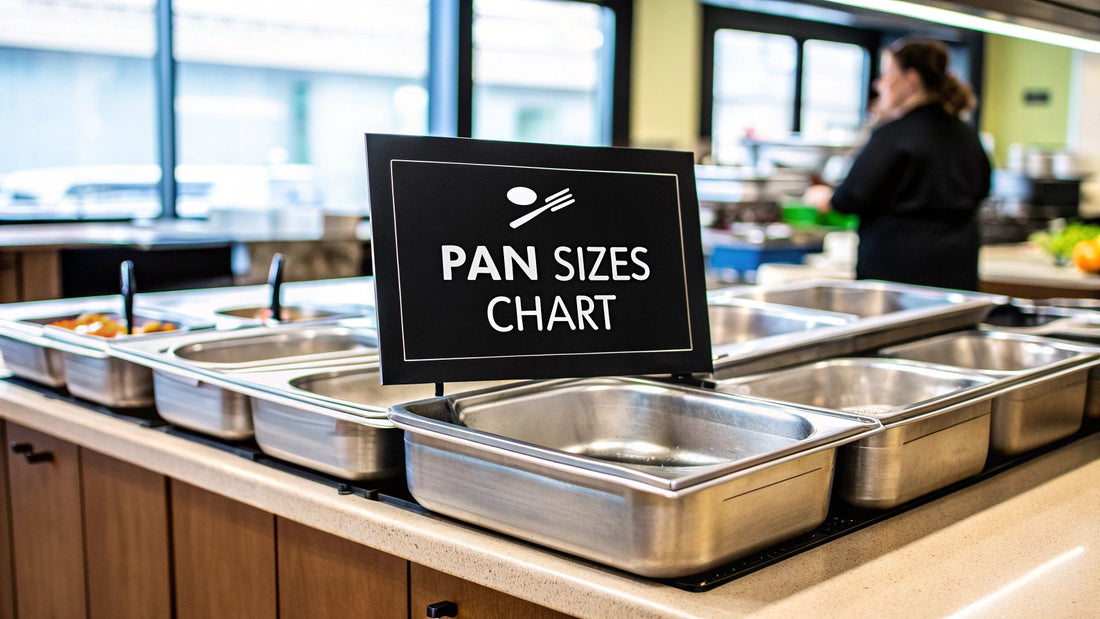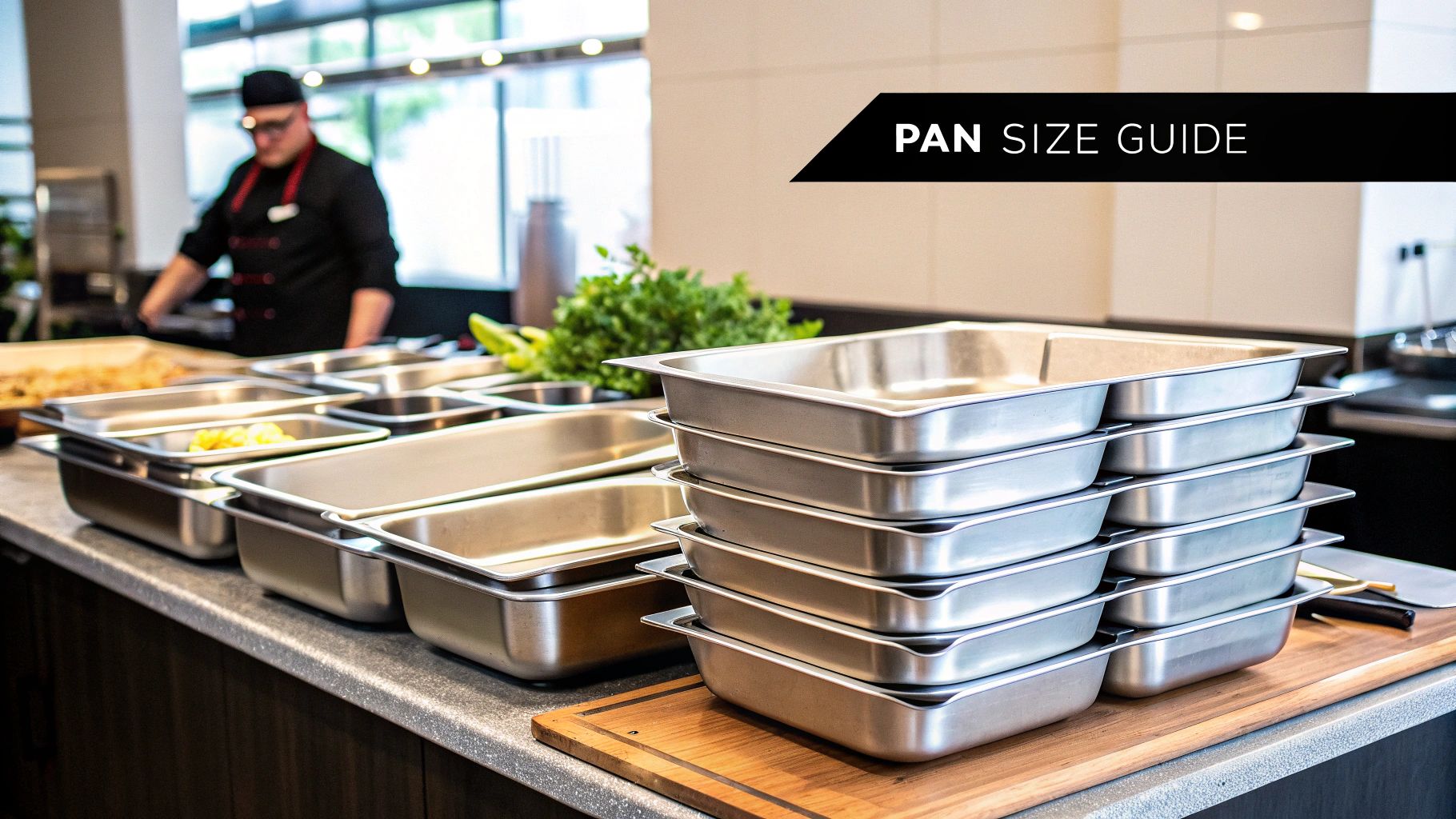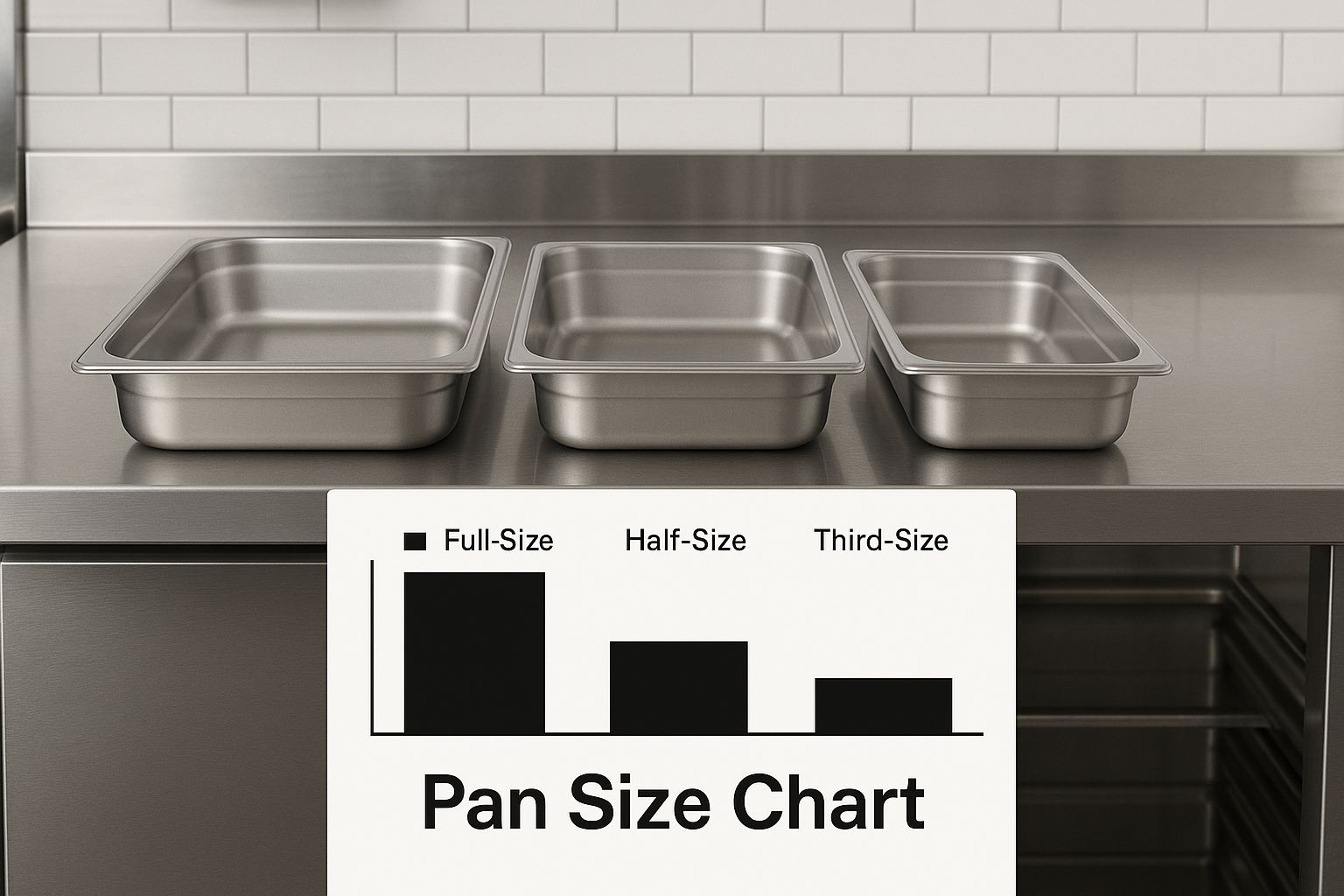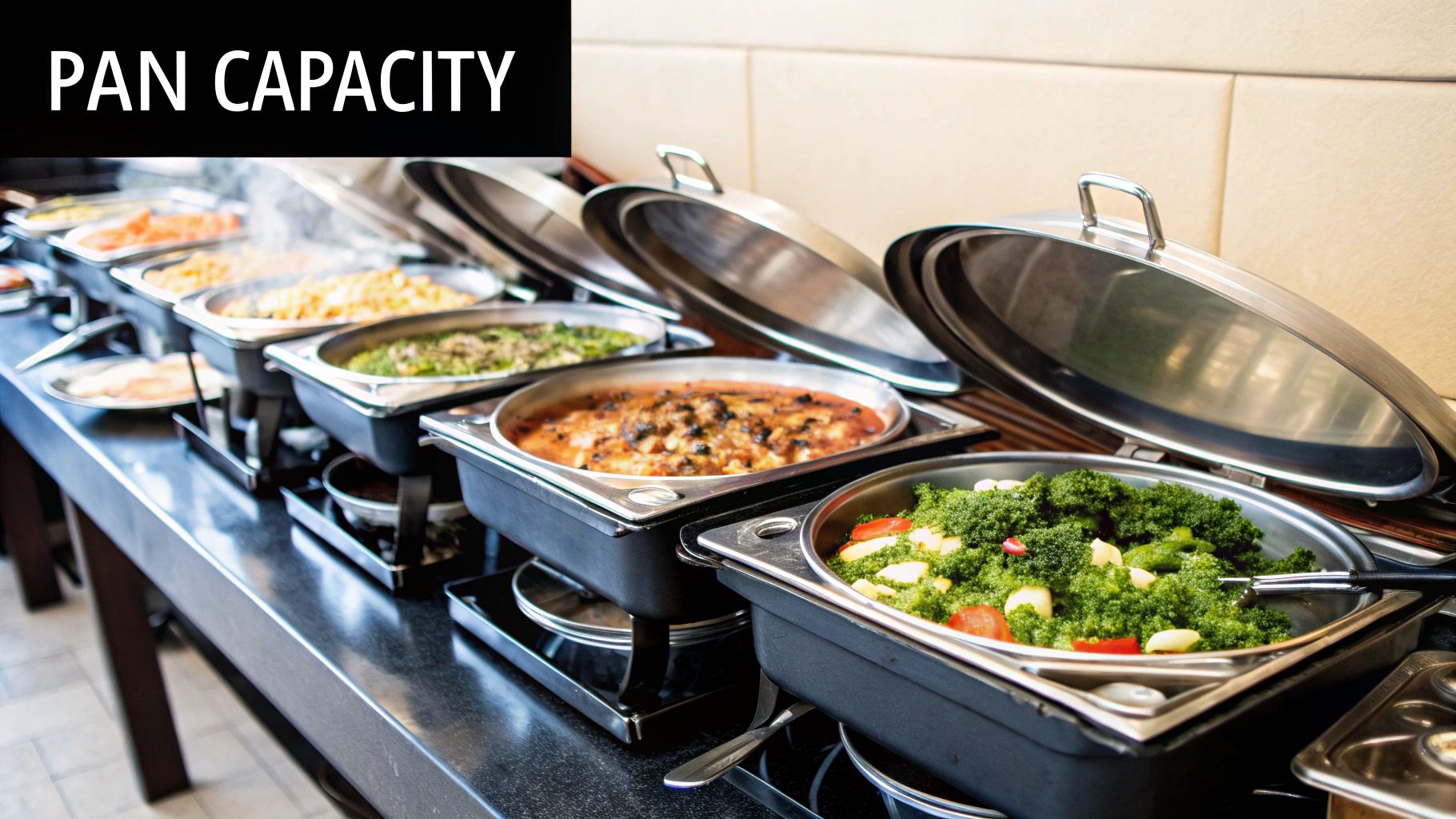
Hotel Pan Sizes Chart A Complete Kitchen Guide
Share
If you've spent any time in a commercial kitchen, you know that hotel pans are the unsung heroes of food service. Everything is built around them. The system starts with the standard full-size pan, which measures roughly 12 by 20 inches. All other common sizes—like half-pans, third-pans, and so on—are simply fractions of this one universal footprint. This clever modularity is what makes the whole system work so well.
Your Essential Hotel Pan Sizes Quick Reference

Knowing your pan sizes isn't just trivia; it's fundamental to running an efficient kitchen. This entire system was designed so that pans fit seamlessly into steam tables, prep stations, and walk-in coolers—all of which are built to accommodate these exact dimensions. It’s what allows a busy line to swap out a pan of macaroni and cheese for a fresh one in seconds, without any guesswork.
Think of this guide as your go-to cheat sheet for making those quick decisions on the fly. Use it to find the right pan for any job, whether you're batching sauces or setting up a salad bar. Getting this right keeps your entire operation running smoothly. We'll start with a quick overview of the most common sizes to lay the groundwork for the more detailed charts ahead.
Let’s start with a high-level look at the most common pan footprints you'll encounter. These are the absolute basics every kitchen professional should know by heart.
Quick Reference Hotel Pan Dimensions
| Pan Size Name | Nominal Dimensions (Inches) | Common Applications |
|---|---|---|
| Full-Size Pan | 12" x 20" | Roasting large cuts of meat, catering, batch cooking |
| Half-Size Pan | 12" x 10" | Side dishes on a buffet line, smaller batch prep |
| Third-Size Pan | 12" x 6 ⅔" | Condiments, toppings, ingredients on a prep line |
| Sixth-Size Pan | 6" x 6 ⅔" | Salad bar toppings, holding small quantities of spices |
| Ninth-Size Pan | 4" x 6 ⅔" | Garnishes, rare spices, mise en place for fine dining |
This table covers the length and width, but the real magic comes from combining these footprints with different depths to get the exact volume you need for a specific task.
How Standardized Pans Shape the Modern Kitchen
The hotel pan system is so ingrained in today's professional kitchens that it's easy to take for granted. But it wasn't always this organized. This brilliant modular standard came about in the United States around the mid-20th century, born out of a desperate need for uniformity as the hotel and restaurant industry boomed.
At the very center of it all is the full-size hotel pan, with its standard footprint of 12 inches by 20 inches. This isn't just a random size; it's the foundational block that nearly everything else is built around. Steam tables, prep stations, walk-in shelving, and commercial ovens are all designed to accommodate this exact dimension, ensuring every piece of equipment plays nicely together. You can see just how critical these standards are by checking out our guide on efficient commercial kitchen design.
Why Modularity is Everything
This "one-size-fits-all" approach has a massive impact on the daily grind and, ultimately, a kitchen's bottom line. When your equipment is designed to hold these specific pans, you unlock a new level of speed and flexibility.
- A Smoother Workflow: Imagine pulling a pan of prepped ingredients from the walk-in, sliding it into the prep line, and then moving it directly into a steam table for service. No need to transfer the contents, which means less labor and less mess.
- Cutting Down on Food Waste: The system's fractional sizes are a game-changer for portion control. You can use smaller pans during slower periods, helping you hold just enough product without costly over-preparation.
- Better Food Safety: A snug, proper fit in steam tables and cold wells is non-negotiable. It ensures the pans maintain safe holding temperatures, which is absolutely critical for preventing foodborne illness.
It's tough to overstate how important this system is. By creating a universal footprint for pans, the industry unlocked a level of operational efficiency that makes serving hundreds of guests, quickly and safely, even possible.
This powerful modularity is exactly why any serious kitchen pro needs to understand hotel pan sizes. It's the unspoken language that keeps the back-of-house running like a well-oiled machine.
The Complete Hotel Pan Sizes Chart
This is your go-to reference for every standard hotel pan size out there. From the workhorse full-size pan all the way down to the tiny ninth-size, the chart below gives you the exact dimensions you need to know, in both inches and millimeters.
Whether you're outfitting a new kitchen, laying out a buffet, or just trying to maximize your prep line, getting these sizes right is crucial. Think of this as your cheat sheet for optimizing your entire kitchen workflow.
This visual guide is a great way to see how the most common sizes—full, half, and third—fit together on a standard kitchen counter. It really helps you picture the modular system in action.

As you can see, the whole system is designed so that the smaller "fractional" pans fit perfectly inside the footprint of a standard full-size pan. Understanding this is the secret to building flexible steam tables and efficient prep stations.
Comprehensive Hotel Pan Dimensions and Fractional Sizes
The hotel pan sizes chart below breaks down all the industry-standard sizes. It's worth noting that dimensions might vary ever so slightly from one manufacturer to another, but these are the nominal measurements everyone in the business uses.
| Pan Size | Fractional Size | Dimensions (Inches) | Dimensions (mm) |
|---|---|---|---|
| Full-Size | 1/1 | 20 ¾" x 12 ¾" | 530 x 325 mm |
| Two-Thirds Size | 2/3 | 13 ⅞" x 12 ¾" | 354 x 325 mm |
| Half-Size | 1/2 | 12 ¾" x 10 ⅜" | 325 x 265 mm |
| Third-Size | 1/3 | 12 ¾" x 6 ⅞" | 325 x 176 mm |
| Quarter-Size | 1/4 | 10 ⅜" x 6 ⅜" | 265 x 162 mm |
| Sixth-Size | 1/6 | 6 ⅞" x 6 ⅜" | 176 x 162 mm |
| Ninth-Size | 1/9 | 6 ⅞" x 4 ¼" | 176 x 108 mm |
Use this chart as your primary tool to make sure everything fits when you're buying new pans or mapping out a station. For example, you can quickly see that two half-size pans or three third-size pans will slot perfectly into a full-size opening.
Mastering these combinations is what lets you build adaptable serving lines that can handle anything from a brunch rush to a fine-dining service.
Matching Pan Depth with Food Capacity
While a pan's length and width tell you what space it'll take up on the line, its depth is what really matters for volume and portioning. Getting the depth right is a crucial part of managing recipes, controlling inventory, and keeping food waste in check. The most common depths you'll run into are 2.5 inches, 4 inches, and 6 inches, but you'll find plenty of others out there too.
A shallow 2.5-inch pan, for instance, is your best friend for anything that needs to heat evenly or shouldn't be piled high. Think roasted vegetables, delicate fish fillets, or even a nice sheet cake. Once you get into deeper pans, you're talking about holding soups, sauces, or big-batch recipes.

This link between a pan's depth and its capacity is a cornerstone of smart kitchen management. Choosing the right combination means you're not constantly over-prepping or, even worse, running out of a key menu item during a rush. It all comes down to profitability.
Linking Depth to Volume
To make the right call, you have to know exactly how depth translates into real-world volume. For example, a 4-inch deep half-pan is a workhorse in countless kitchens for holding popular sides like mashed potatoes or macaroni and cheese. It holds a generous amount without hogging a full-size slot on the steam table. This is where a good hotel pan sizes chart that clearly lists volumes becomes an indispensable tool.
Knowing how to map pan depth to capacity gives a chef the confidence to scale recipes precisely. It ensures consistency, whether you're feeding a party of 50 or a banquet of 500.
Looking at the numbers from large-scale operations really shows how dramatically capacity scales with depth. A full-size hotel pan (12" x 20") with a 4-inch depth will hold about 53 cups (or 12.5 liters). Bump that up to a 6-inch deep version, and you're suddenly looking at a capacity of around 79 cups (18.75 liters).
Grasping these volumes is also critical when it's time to choose serving equipment. You can dive deeper into this by checking out our guide on chafing dish sizes to see how they pair up perfectly with standard hotel pans.
A Guide to Gastronorm (GN) Sizes for Global Kitchens
While most American kitchens are built around the standard 12” x 20” hotel pan, things look a little different once you step onto the international stage. If you're working with European equipment or in kitchens abroad, you'll be using the Gastronorm (GN) system.
The Gastronorm standard is the universal language for food containers across Europe, the Middle East, and much of the world. It all starts with the foundational GN 1/1 pan, which measures 530 mm by 325 mm. That’s roughly 20.9" x 12.8", making it very close—but not identical—to the American full-size pan. You can dig deeper into the system's history over on the Gastronorm sizing page on Wikipedia.
Key Differences Between GN and U.S. Pans
They look similar, but those tiny measurement differences can cause big problems in a busy kitchen. Try to slide a Gastronorm pan into a U.S. steam table, and you might find it fits loosely, letting precious heat and steam escape. On the flip side, an American hotel pan can be just a little too tight for a well designed for GN pans.
It's a classic case of "close doesn't count." Knowing the subtle but critical variations between Gastronorm and U.S. pan sizes is the key to avoiding expensive purchasing mistakes and making sure your equipment works together perfectly.
Before you buy, always double-check the exact measurements. A comprehensive hotel pan sizes chart that includes both U.S. and GN dimensions is an invaluable tool for any kitchen sourcing equipment globally. Below, we'll compare the most common sizes to show you exactly where they align and where they differ.
Choosing the Right Pan Material for Any Task
Getting the size right is only half the battle. The material of your hotel pans plays a huge role in how they perform, how long they last, and even how safe they are for your food. Picking the best material for the job is a detail that separates a good kitchen from a great one. Staying informed about the latest trends in equipment and supplies, like new pan materials, can give you a competitive edge.
Stainless steel is the undisputed king of the hot line, and for good reason. It’s tough enough to go straight from a blistering oven to a steam table without missing a beat. The key thing to look for here is the gauge—a lower number means a thicker, more robust pan. A 22-gauge pan, for instance, is a real workhorse that will resist warping and denting far better than a thinner one. They’re heavier, sure, but that extra heft translates to more even heating, which is a worthy trade-off for any busy kitchen. To get a better sense of all your options, check out our complete guide on the many types of cooking pans available.
Specialized Materials for Specific Needs
While stainless steel is fantastic, sometimes you need a more specialized tool for the job. That's where other materials come into play.
-
Polycarbonate Pans: These clear plastic pans are a game-changer for cold storage. You can see exactly what’s inside at a glance, which saves a ton of time rummaging through the walk-in and helps keep your temperature logs consistent.
-
Perforated Pans: Got something to steam or drain? These are what you need. The holes let steam circulate perfectly around vegetables and allow excess liquid to drain away from proteins, so your food isn't left sitting in a puddle.
-
Anti-Jam Designs: This is a simple but brilliant feature. Pans with reinforced, flattened edges won't create a vacuum seal and get stuck together when you stack them. It might seem small, but it saves a ton of frustration during a chaotic service rush.
My advice? Don't stick to just one type. Having a mix of materials makes your kitchen far more efficient. Use clear pans for your cold prep station and heavy-duty steel for the hot line—you'll always have the right tool right when you need it.
If you’re looking into more high-end or specialized options, some manufacturers are doing interesting things with materials like titanium as a pan material, which offers its own unique set of benefits.
Still Have Questions About Hotel Pans? We’ve Got Answers.
We get a lot of questions about hotel pans, and for good reason. Getting the details right can make all the difference in a busy kitchen. Here are answers to some of the most common things chefs and kitchen managers ask us.
Can I Use Gastronorm Pans in a US Steam Table?
You'd think they'd be interchangeable, but it's not always a perfect fit. While GN pans and U.S. hotel pans are close in size, they aren't identical. A GN 1/1 pan, for example, is a little wider and shorter than its U.S. counterpart.
This small difference can cause gaps in a standard U.S. steam table, letting heat escape and making your equipment less efficient. The best bet is to measure your steam table wells first or grab a set of adapter bars to ensure a snug, secure fit.
What Is the Difference Between 22 and 24 Gauge Stainless Steel?
This is all about thickness and durability. With stainless steel, the lower the gauge number, the thicker and stronger the metal.
A 22-gauge pan is significantly more robust than a 24-gauge one, meaning it will stand up much better to the daily grind of a commercial kitchen without denting or warping. If you’re running a high-volume operation, investing in the lower gauge is always the smarter long-term choice.
At Encore Seattle Restaurant Equipment, we do more than just sell supplies; we help restaurant owners and chefs like you discover the latest news and exclusive deals. We keep you informed about critical industry trends so you can choose the durable, high-quality hotel pans and accessories your kitchen needs to perform at its best. Check out our huge selection of new and used equipment online.
